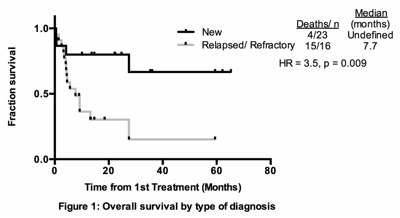Abstract
Non-Hodgkin’s lymphomas with secondary involvement of the central nervous system (CNS) typically carry a poor prognosis. There is limited data in the literature regarding the optimal therapy for these patients. IDARAM is a cytotoxic regimen which penetrates the CNS. It has demonstrated efficacy in early studies in secondary CNS lymphoma [Moreton et al, Cancer Chemother Pharmacol (2004) 53: 324–8]. We present here the largest series of patients with secondary CNS involvement treated with IDARAM+/- rituximab at University College Hospital London between June 2005 and January 2013.
Thirty-eight patients were treated with 1-4 cycles of IDARAM, consisting of methotrexate 12.5mg by intrathecal injection day 1; idarubicin daily 10mg/m2 IV days 1 and 2; dexamethasone 100mg daily IV infusions of 12h duration days 1-3; cytosine arabinoside daily 1000mg/m2 IV over 1 hour days 1 and 2; and methotrexate 2000mg/m2 IV over 2 hours day 3. CSF was analysed for lymphomatous involvement by flow cytometry on D1. Patients with a clear CSF from the outset only received one intrathecal injection on day 1 of cycle 1. Most patients with B-cell lymphoma additionally received 1-2 doses of rituximab 375 mg/m2 IV on day 1 (+/- day 8) of each cycle.
Baseline characteristics are presented in table 1. 16/38 (42%) patients had secondary CNS involvement at the time of initial diagnosis of NHL or within 2 months (‘New Diagnosis’). 22/38 (58%) had refractory (CNS involvement diagnosed in latter part of therapy or within 3 months of completion of primary therapy) or relapsed (CNS involvement diagnosed at relapse - either combined with a systemic relapse or isolated to CNS) disease. 84 cycles of IDARAM were delivered to 38 patients. Patients received a median of 2 cycles. 20/37 responded (overall response rate (ORR) = 54%) with 12/37 (32%) achieving a complete response and 8/37 (22%) a partial response (PR). Median progression-free survival (PFS) was 6.8 months and overall survival (OS) was 27.5 months. In patients with a ‘New’ diagnosis ORR was 10/15 (67%) CR 7/15 (47%), PR 3/15 (20%), median PFS was 48 months, median OS has not been reached (see figure 1). Neither age nor performance score predicted outcome in these patients.
Baseline characteristics of patients
| Parameter . | n (%) or Median [Range] . |
|---|---|
| Male Gender | 22 (58) |
| Age (Years) | 55 [25-71] |
| Performance Status | 2 [0-4] |
| High Grade Disease | 30 (79) |
| B-Cell Lymphoma | 34 (89) |
| Type of Diagnosis | |
| - New | 15 (40) |
| - Relapsed | 16 (43) |
| - Primary Refractory | 6 (16) |
| CSF Involved | 23 (66) |
| IPI (High Grade Only) | 3 [0-5] |
| Parameter . | n (%) or Median [Range] . |
|---|---|
| Male Gender | 22 (58) |
| Age (Years) | 55 [25-71] |
| Performance Status | 2 [0-4] |
| High Grade Disease | 30 (79) |
| B-Cell Lymphoma | 34 (89) |
| Type of Diagnosis | |
| - New | 15 (40) |
| - Relapsed | 16 (43) |
| - Primary Refractory | 6 (16) |
| CSF Involved | 23 (66) |
| IPI (High Grade Only) | 3 [0-5] |
Grade 3 or 4 haematological toxicity was observed in 100% of cycles. Non-haematological grade 3 or 4 toxicities included infection 81%, stomatitis 11.3%, diarrhoea 4.3%, other 6.5%. 4/84 (5%) of cycles were complicated by ITU stay and treatment-related mortality was 2/38 (5%).
8 (21%) of patients received consolidation radiotherapy (4 patients in CR, 4 in PR), 4 patients (10%) received salvage radiotherapy for disease refractory to IDARAM, and 3 patients (8%) received palliative radiotherapy. 8 patients (20%) received an autologous stem cell transplant; 6 (75%) as consolidation and 2 (25%) for disease relapsing after IDARAM. Conditioning was with TBI in 6 (75%) and LEAM/ BEAM in 2 (25%). 2 patients received reduced-intensity conditioned allogeneic stem cell transplants from HLA-matched unrelated donors: one for primary refractory disease and one for relapsed disease after autograft in 1st CR. Of 10 newly diagnosed patients achieving CR/PR with IDARAM, 5/5 who received consolidation autograft, and 4/5 who did not, remain alive (median follow-up 30 months). 1 patient in each group has relapsed.
IDARAM +/- R is a well-tolerated regime with encouraging response rates in patients with poor prognosis lymphoma. The short duration of survival of patients with relapsed or refractory disease indicates the urgent need to identify efficacious new treatments for these patients. Patients in whom CNS involvement is detected early in the disease course fare reasonably well, including older patients and those with a poor performance status.
No relevant conflicts of interest to declare.
Author notes
Asterisk with author names denotes non-ASH members.


